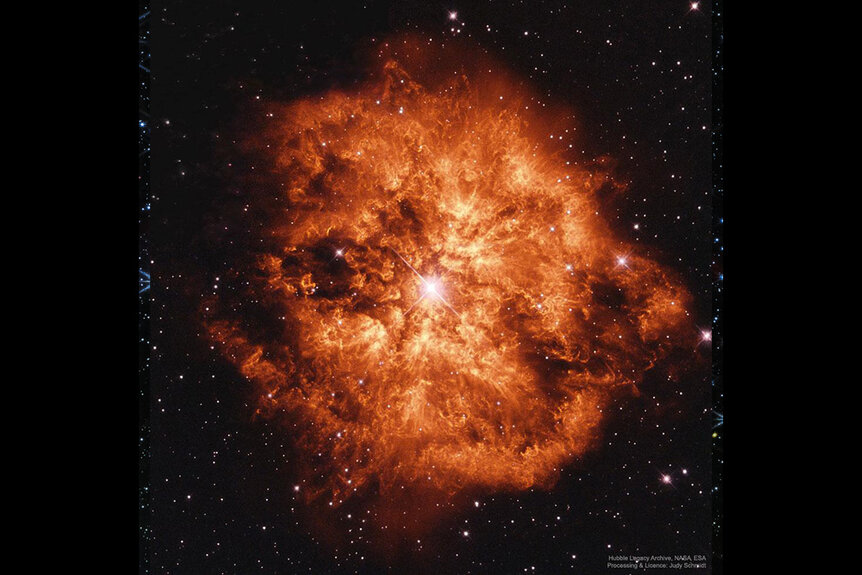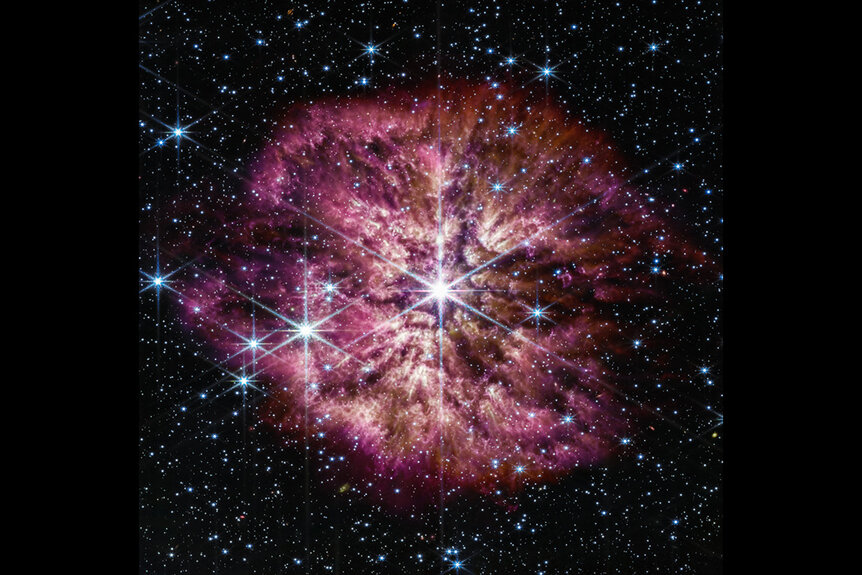Create a free profile to get unlimited access to exclusive videos, sweepstakes, and more!
JWST captures the countdown to a supernova 15,000 light years away
It's gonna blow!

Humanity is compelled, sometimes against our better judgment, to push against boundaries and carve out new horizons. Every mountain range, apparently impassable desert, and endless ocean has fallen beneath the unstoppable force of our technology and ambition. If we can walk somewhere, we will walk there. If we must climb something, we will climb it. And if we can’t do either, we will build a machine that can. That’s how an animal which is not far removed from banging rocks together in caves can visit the deepest parts of the oceans, soar through the skies, and push our rockets through the veil of heaven to gaze upon eternity with our own eyes. Of course, our ambition can also be our downfall when things don’t go exactly to plan.
The crew of The Ark (now streaming on Peacock!) learned that the hard way during a years-long trip to Proxima Centauri. Their plan is to sleep during the trip and land on a planet orbiting that star, known as Proxima Centauri b. Certainly, Proxima Centauri has a few things going for it. It is – along with its binary companion Alpha Centauri – the closest star to us and it has a planet which is potentially Earth-like and orbiting within its star’s habitable zone.
RELATED: 'The Ark' co-creator Jonathan Glassner says he 'could write a whole show' on the subject of cloning
The thing is, the habitable zone around a red dwarf star like Proxima Centauri is a lot closer in than we’re used to. As a result, the year on Proxima Centauri b only lasts about 11 days, which might make planning next week’s outdoor activities a little difficult when you’re not quite sure what season it might be. The good news is, if we could get there and set up shop, we might be okay for quite a while. The estimated lifespan of Proxima Centauri is roughly four trillion years, approximately 400 times longer than our own Sun.
It might not be the best star to try and visit (let alone live next to) but it definitely isn’t the worst. There are plenty of stars which are way less hospitable and, recently, astronomers using NASA’s James Webb Space Telescope (JWST) got a rare view into one of the deadliest and most interesting kinds of stars out there: a Wolf-Rayet star.
WHAT ARE WOLF-RAYET STARS?
Wolf-Rayet stars (commonly called WR stars) are exceedingly rare, at least as far as we are able to tell. To date, only a few hundred have been discovered, out of the trillions and trillions of stars we can see in the night sky. Their rarity is especially interesting once we consider some of their characteristics. WR stars are among the hottest and most luminous stars in the universe, with masses at least 20 times that of the Sun and surface temperatures upward of 50,000 Kelvin. For comparison, the Sun’s surface temperature taps out at about 6,000 Kelvin. There aren’t a lot of WR stars out there, but they are practically screaming for attention. You might think that would mean they’d be easy to find, but there’s a good reason we don’t see them very often.
For a star like the Sun, stable fusion reactions can proceed mostly without a hiccup for billions of years. The expected lifespan of our own parent star is somewhere on the order of 10 billion years, and you want that sort of stability if you’re planning to make planets and allow something to live on them.
RELATED: JWST captures lightyear-wide dust rings around dying binary star
Contrary to common sense, one of the reasons our star will live so long is because it’s not very massive (cosmically speaking). It makes a sort of intuitive sense that the more massive a star is, the more fuel it has to burn, and the longer it will last. But the universe doesn’t care about our intuitions. The reality is, the more mass a star has, the more gravity is working upon it and the more internal pressure there is. That means that even though massive stars have way more material to work with, they burn through it a lot faster. If our own Sun is a comfortable campfire, the most massive stars are forest fires. They have a lot more fuel but they’re gobbling it up like they’re running out of time.
The most massive star we know of, R136a1 in the Tarantula Nebula, has a mass roughly 350 times that of the Sun. If it burned that fuel at the same rate as the Sun, we could expect it to last more than 3 trillion years, but it wasn’t meant to be. The ravenous rate of fusion happening inside R136a1 means it will consume all of its considerable fuel in approximately 4,400 years. It’s barely a flash in the pan, but it’s an incredible flash!
That’s why WR stars are so rare. Only stars with more than 20 solar masses are capable of undergoing a Wolf-Rayet stage, and only in the brief period right before they go supernova. Despite going off like a flashbang in a dark room, there are so few of them and they exist so briefly that they’re difficult to catch.
AND YET…
Those limitations notwithstanding, the JWST bagged itself a WR star almost as soon as it fired up its machinery, giving astronomers an unprecedented look at the lead up to an incredible stellar explosion. WR 124 lies roughly 15,000 lightyears from us, in the constellation Sagitta. The image (pictured above) highlights WR 124 in the center of the image, surrounded by a cloud of gas and dust. Current estimates indicate that the star is about 30 times more massive than the Sun and has already shed enough material to make up ten Suns. As all of that material cascades away from the star, pushed by the force of its last gasp, it cools, painting the sky with a cloud of cosmic dust glowing in the infrared.
Seeing a star go through this period of its life cycle is of considerable interest to astronomers. Not only does it have the potential to expand our understanding of how stars evolve, but it could also help us figure out where all of the universe’s dust comes from.
RELATED: NASA renames new space telescope after pioneering astronomer Nancy Grace Roman
Our present models, impressive as they are, don’t explain all of the dust we see in the cosmos. Much like the tucked away corners of your home, we have more dust than we know how to account for. Seeing these Wolf-Rayet dust production factories in action could help astronomers to align their models more closely to reality, according to NASA.
Before the JWST, we weren’t able to capture data with enough detail and precision to determine if dust grains produced by WR stars were large enough to survive the coming supernova explosion and contribute to the observed surplus of dust in the universe. Observations like these give astronomers real data to work with for the first time.
That data can, of course, provide information about the stars lighting up the night sky today but it might also serve as a window into the early universe by allowing astronomers to see the sorts of conditions early stars might have undergone. Stars like WR 124 use their incredible gravitational pressure to fuse increasingly heavy elements in their cores, before scattering them in violent supernovae explosions. The leftover materials eventually reform into planets with the necessary ingredients to make people and orbiting telescopes. Then, with enough time and a little luck, some of those supernovae guts might wake up enough to ask where they came from. With a little bit more luck, and some more observations like these, we might actually figure it out one day.
While you’re waiting for the next earth-shattering JWST images, catch up on The Ark, every Wednesday at 10 p.m. ET. on SYFY, then streaming the next day on Peacock!
































